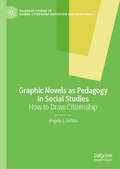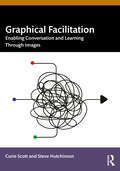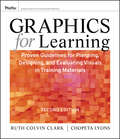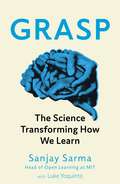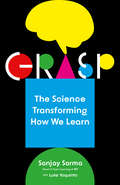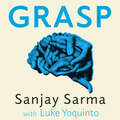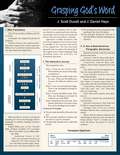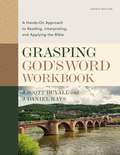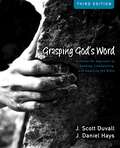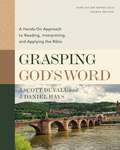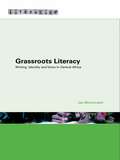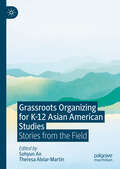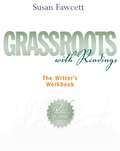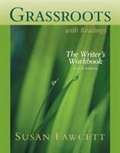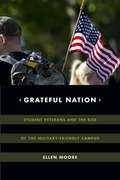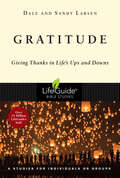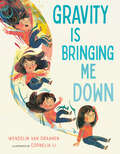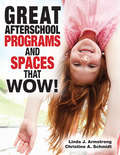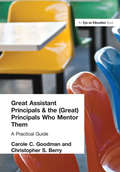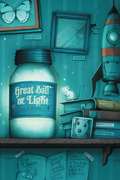- Table View
- List View
Graphic Novels as Pedagogy in Social Studies: How to Draw Citizenship (Palgrave Studies in Global Citizenship Education and Democracy)
by Angelo J. LetiziaThis book examines the study of citizenship by means of reading and creating graphic novels and comics in the social studies classroom. The author argues that utilizing graphic novels in the classroom not only helps to teach important concepts, skills, and dispositions of the social studies, but can also empower students with the means to grapple with the complexities of our current times. From the primary school classroom through high school and beyond, graphic novels provide a rich platform to explore a diverse array of issues such as history, critical geography, gender, race and ethnicity, disability, leadership, feminism, sexual identity, philosophy, and social justice issues, as well as provide a multidisciplinary lens for discourse on citizenship. Cultivating multimodal literacy skills through graphic novels allows students and instructors to conceive of and practice citizenship in new, unforeseen ways in an era where truth is in question. To drive this point forward, the author includes examples of both his own and his students’ work, along with exercises to be used in social studies classrooms.
Graphic Storytelling and Visual Narrative (Will Eisner Instructional Books)
by Will Eisner"There isn't a comics artists alive who hasn't benefited from Will Eisner's masterful work and formidable wisdom."--Scott McCloud, author of Understanding Comics In Graphic Storytelling and Visual Narrative, Will Eisner--one of the most influential comic artists of the twentieth century--lays out the fundamentals of storytelling and their application in the comic book and graphic novel. In a work that will prove invaluable for comic artists and filmmakers, Eisner reveals how to construct a story and the basics of crafting a visual narrative. Filled with examples from Eisner's work as well as that of artists like Art Spiegelman and R. Crumb, this essential work covers everything from the fine points of graphic storytelling to the big picture of the medium, including how to: Combine words and images into seamless storytelling. Wield images like narrative tools. Master different types of comic book stories. Write and illustrate effective dialogue. Develop ideas that can be turned into dynamic stories.
Graphical Facilitation: Enabling Conversation And Learning Through Images
by Steve Hutchinson Curie ScottIf ‘a picture is worth a thousand words,’ this book provides an approach to help create professional pictures that productively and powerfully capture conversations and thinking for individual and collective learning. Individuals are bombarded by information, and organizations, managers, and teachers often lack a corresponding set of tools to make sense of this complexity—resulting in far too many “death by bullet-point” presentations. This is that toolkit, also offering invitations to readers to extend their thinking past these tools to enable the creation (and co-creation with teams, learners, and clients) of graphical depictions, models, and metaphors to help people make sense of their world. This accessible book is constructed as a visual reference so readers can quickly pick out the specific tool or strategy they need, whether working with individuals and teams to promote self-awareness, develop emotional intelligence, improve communication, or articulate vision and strategy.This clear and adaptable guide will be a welcome resource for teachers, trainers, managers, and coaches to empower people to learn, think, and create in a powerful, memorable, and graphical way.
Graphics for Learning
by Clark Ruth C. Chopeta LyonsThis second edition of the bestselling book summarizes guidelines for best use of graphics for instructional materials, including multimedia, texts, classroom aids, and slides used for briefings. These guidelines are based on updated scientific research and contain illustrative examples including examples for readers without a background in psychology. The authors help trainers tie graphics into their lesson topics and include facts, concepts, processes, procedures, and principles. The book discusses technical and environmental issues (such as bandwidth or screen size) that will influence how instructional professionals can apply the guidelines.
Grasp: The Science Transforming How We Learn
by Sanjay Sarma Luke Yoquinto'Sarma's book may be the most important work on education written this century' - SkepticAs the head of Open Learning at MIT, Sanjay Sarma has a daunting job description: to fling open the doors of the MIT experience for the benefit of the wider world. But if you're going to undertake such an ambitious project, you must first ask: How exactly does learning work? What conditions are most conducive? Are our traditional classroom methods - lecture, homework, test, repeat - actually effective? And if not, which techniques are?Grasp takes readers across multiple frontiers, from fundamental neuroscience to cognitive psychology and beyond, as it explores the future of learning. For instance:· Scientists are studying the role of forgetting, exposing it not as a simple failure of memory but a critical weapon in our learning arsenal· New developments in neuroimaging are helping us understand how reading works in the brain. It's become possible to identify children who might benefit from specialised dyslexia interventions - before they learn to read· Many schools have begun converting to flipped classrooms, in which you watch a lesson at home, then do your 'homework' in classAlong the way, Sarma debunks long-held views such as the noxious idea of 'learning styles,' while equipping readers with a set of practical tools for absorbing and retaining information across a lifetime of learning. He presents a vision for learning that's more inclusive and democratic - revealing a world bursting with powerful learners, just waiting for the chance they deserve.Drawing from the author's experience as an educator and the work of researchers and educational innovators at MIT and beyond, Grasp offers scientific and practical insight, promising not just to inform and entertain readers but to open their minds.
Grasp: The Science Transforming How We Learn
by Sanjay Sarma Luke YoquintoA groundbreaking look at the science of learning—how it's transforming education and how we can use it to discover our true potential, as individuals and across society by a renowned MIT professorAs the head of Open Learning at MIT, Sanjay Sarma has a daunting job description: to fling open the doors of the MIT experience for the benefit of the wider world. But if you're going to undertake such an ambitious project, it behooves you to ask: How exactly does learning work? What conditions are most conducive? Are our traditional classroom methods—lecture, homework, test, repeat—actually effective? And if not, which techniques are? Grasp takes readers across multiple frontiers, from fundamental neuroscience to cognitive psychology and beyond, as it explores the future of learning. Some of its findings: • Scientists are studying the role of forgetting, exposing it not as a simple failure of memory but a critical weapon in our learning arsenal. • New developments in neuroimaging are helping us understand how reading works in the brain. It's become possible to identify children who might benefit from specialized dyslexia interventions—before they learn to read.• Many schools have begun converting to flipped classrooms, in which you watch a lesson at home, then do your 'homework' in class. Through such bold instructional changes, MIT has eliminated the gender performance gap in its introductory physics courses.• By structuring its curriculum to better incorporate cutting-edge learning strategies, one law school in Florida has rocketed to the top of its state in bar exam passage rates. Along the way, Sarma debunks long-held views (such as the noxious idea of "learning styles"), while equipping readers with a set of practical tools for absorbing and retaining information across a lifetime. He presents a vision for learning that's more inclusive and democratic—revealing a world bursting with powerful learners, just waiting for the chance they deserve. Drawing from the author's experience as an educator and the work of researchers and educational innovators at MIT and beyond, Grasp offers scientific and practical insight, promising not just to inform and entertain readers but to open their minds.
Grasp: The Science Transforming How We Learn
by Sanjay Sarma Luke Yoquinto'Sarma's book may be the most important work on education written this century' - SkepticAs the head of Open Learning at MIT, Sanjay Sarma has a daunting job description: to fling open the doors of the MIT experience for the benefit of the wider world. But if you're going to undertake such an ambitious project, you must first ask: How exactly does learning work? What conditions are most conducive? Are our traditional classroom methods - lecture, homework, test, repeat - actually effective? And if not, which techniques are?Grasp takes readers across multiple frontiers, from fundamental neuroscience to cognitive psychology and beyond, as it explores the future of learning. For instance:· Scientists are studying the role of forgetting, exposing it not as a simple failure of memory but a critical weapon in our learning arsenal· New developments in neuroimaging are helping us understand how reading works in the brain. It's become possible to identify children who might benefit from specialised dyslexia interventions - before they learn to read· Many schools have begun converting to flipped classrooms, in which you watch a lesson at home, then do your 'homework' in classAlong the way, Sarma debunks long-held views such as the noxious idea of 'learning styles,' while equipping readers with a set of practical tools for absorbing and retaining information across a lifetime of learning. He presents a vision for learning that's more inclusive and democratic - revealing a world bursting with powerful learners, just waiting for the chance they deserve.Drawing from the author's experience as an educator and the work of researchers and educational innovators at MIT and beyond, Grasp offers scientific and practical insight, promising not just to inform and entertain readers but to open their minds.
Grasping God's Word Laminated Sheet: A Hands-on Approach To Reading, Interpreting, And Applying The Bible (Zondervan Get an A! Study Guides)
by J. Daniel Hays J. Scott DuvallWhether studying for exams or delving into the Scriptures, Bible students will love how this Zondervan Get an A! Study Guide puts critical information at their fingertips. No more hunting through textbooks or laboring over self-made study cards. This study resource is ideal for obtaining a quick overview of Scott Duvall and Daniel Hays' Grasping God's Word for exam preparation and last-minute review, or as an aid in Bible study.
Grasping God's Word Workbook, Fourth Edition: A Hands-On Approach to Reading, Interpreting, and Applying the Bible
by J. Daniel Hays J. Scott DuvallA Companion WORKBOOK to Today's Most Widely Used Textbook for Learning to Interpret and Understand the BibleGrasping God's Word has proven itself in classrooms across the country as an invaluable help to students who want to learn how to read, interpret, and apply the Bible for themselves. This WORKBOOK is designed for use alongside the fourth edition of the textbook Grasping God's Word. While the textbook shows you the principles and tools of interpretation, the WORKBOOK lets you try them out by applying them to specific genres and contexts. Together, these books will help you get a grip on the solid rock of Scripture--how to read it, how to interpret it, and how to apply it.Filling the gap between approaches that are too simple and others that are too technical, this book starts by equipping readers with general principles of interpretation, then moves on to apply those principles to specific genres and contexts. Features include:Proven in classrooms across the countryHands-on exercises to guide students through the interpretation processEmphasis on real-life applicationSupplemented by a website for professors providing extensive teaching materialsUpdates corresponding to the fourth edition of the textbook, including new exercisesAccompanying textbook, video lectures, laminated study guide (sold separately)When used alongside the textbook, this workbook is the ideal resource for anyone looking for a hands-on step-by-step guide that will teach them how to accurately and faithfully interpret the Bible.
Grasping God's Word Workbook: A Hands-On Approach to Reading, Interpreting, and Applying the Bible
by J. Daniel Hays J. Scott DuvallThe widely used Grasping God’s Word, now in a revised third edition, teaches the foundational principles and tools of biblical interpretation. J. Scott Duvall, who specializes in New Testament studies, and Old Testament scholar J. Daniel Hays survey numerous biblical passages, demonstrating solid interpretive strategies for understanding the Bible. This workbook is designed to use alongside the Grasping God’s Word textbook, following its structure with activities that offer additional practice for all the elements of faithful scholarship as they are presented. College-level students and other serious learners will have the opportunity to try out their interpretive skills by applying them to specific genres and contexts. Both Grasping God’s Word and Grasping God’s Word Workbook treat Scripture as the solid rock of Christian faith, one that students will grip more easily when they know how to read it, how to interpret it, and how to apply it.
Grasping God's Word, Fourth Edition: A Hands-On Approach to Reading, Interpreting, and Applying the Bible
by J. Daniel Hays J. Scott DuvallA Proven Approach to Help You Interpret and Understand the BibleGrasping God's Word has proven itself in classrooms across the country as an invaluable help to students who want to learn how to read, interpret, and apply the Bible for themselves. This book will equip you with a five-step Interpretive Journey that will help you make sense of any passage in the Bible. It will also guide you through all the different genres found in the Bible to help you learn the specifics of how to best approach each one.Filling the gap between approaches that are too simple and others that are too technical, this book starts by equipping readers with general principles of interpretation, then moves on to apply those principles to specific genres and contexts.Features include:Proven in classrooms across the countryHands-on exercises to guide students through the interpretation processEmphasis on real-life applicationSupplemented by a website for professors providing extensive teaching materialsAccompanying workbook, video lectures, laminated study guide (sold separately)This fourth edition includes revised chapters on word studies and Bible translations, updated illustrations, cultural references, bibliography, and assignments. This book is the ideal resource for anyone looking for a step-by-step guide that will teach them how to accurately and faithfully interpret the Bible.
Grasping God's Word: A Hands-On Approach to Reading, Interpreting, and Applying the Bible
by Kevin J. Vanhoozer Mark L. Strauss J. Daniel Hays J. Scott DuvallJust as a rock climber’s handhold enables him to master the mountain, a firm grasp on God’s Word empowers us to traverse the challenging, risky slopes of life. Grasping God’s Word helps college students, beginning seminary students, and other serious readers get a grip on the solid rock of Scripture—how to read it, how to interpret it, and how to apply it. Filling the gap between approaches that are too simple and others that are too technical, this book starts by equipping readers with general principles of interpretation, then moves on to apply those principles to specific genres and contexts. Features include: • Proven in classrooms across the country • Hands-on exercises to guide students through the interpretation process • Emphasis on real-life application • Supplemented by a website for professors providing extensive teaching materials • Accompanying workbook (sold separately) This third edition includes updated illustrations, appendices, bibliography, and assignments, and has been rearranged for clarity. In order to emphasize the redemptive narrative arc of the Bible and provide greater canonical correlation, the authors have modified the steps of the Interpretive Journey to include a fifth step throughout the book: 1. Grasp the text in their town. What did the text mean to the biblical audience? 2. Measure the width of the river to cross. What are the differences between the biblical audience and us? 3. Cross the principlizing bridge. What is the theological principle in this text? 4. Cross into the rest of Scripture. Does the rest of the canon’s teaching modify or qualify this principle? 5. Grasp the text in our town. How should Christians today apply the theological principle in their lives? Grasping God’s Word progresses through the following five sections: 1. How to Read the Book—Basic Tools 2. Contexts—Now and Then 3. Meaning and Application 4. The Interpretive Journey—New Testament 5. The Interpretive Journey—Old Testament
Grasshopper (Time-To-Discover)
by Melvin Berger Gilda BergerHow many eyes does a grasshopper have? What is a nymph? What do they eat?
Grassroots Approaches to Combatting Poverty Through Adult Education: Supplement to Adult Education and Development No. 34/1990 (Routledge Library Editions: Adult Education)
by Chris DukeOriginally published in 1990 this supplement to No. 34 (1990) of the journal Adult Education, discusses the relationship between adult education and development. All the studies included in it focus on the reduction of poverty.The majority of the studies cover Africa and South Asia, but there is also one covering the Aboriginal indigenous people of Australia.
Grassroots Literacy: Writing, Identity and Voice in Central Africa (Literacies)
by Jan BlommaertWhat effect has globalization had on our understanding of literacy? Grassroots Literacy seeks to address the relationship between globalization and the widening gap between ‘grassroots’ literacies, or writings from ordinary people and local communities, and ‘elite’ literacies. Displaced from their original context to elite literacy environments in the form of letters, police declarations and pieces of creative writing, ‘grassroots’ literacies are unsurprisingly easily disqualified, either as ‘bad’ forms of literacy, or as messages that fail to be understood. Through close analysis of two unique, handwritten documents from the Democratic Republic of the Congo, Jan Blommaert considers how ‘grassroots’ literacy in the Third World develops outside the literacy-saturated environments of the developed world. In examining these documents produced by socially and economically marginalized writers Blommaert demonstrates how literacy environments should be understood as relatively autonomous systems. Grassroots Literacy will be key reading for students of language and literacy studies as well as an invaluable resource for anyone with an interest in understanding the implications of globalization on local literacy practices.
Grassroots Organizing for K-12 Asian American Studies: Stories from the Field
by Sohyun An Theresa Alviar-MartinThis edited book captures Asian American grassroot organizing in Georgia through counterstorytelling. Rooted in Critical Race Theory and traditions of narrative inquiry, counterstorytelling in educational research seeks to challenge dominant narratives by centering marginalized communities’ experiences and perspectives as sources of valuable knowledge. By employing AsianCrit, global citizenship education, human rights, and liberatory postcolonial education as theoretical lenses, the editors of this book interrupt essentialized portrayals of Asian Americans by featuring stories of Asian American students, parents, and educators who are fighting for Asian American Studies and Ethnic Studies in K-12 schools in Georgia. Their stories capture common as well as divergent experiences of being Asian American in the South and illuminate possibilities, challenges, and complexity of grassroots organizing for Asian American studies and ethnic studies in the South.
Grassroots With Readings: The Writer's Workbook
by Susan FawcettUsing her unique M-A-P approach (Model-Analysis-Practice), Susan Fawcett's books have guided hundreds of thousands of students through the writing process, from foundations of grammar, mechanics, and spelling through writing clear sentences and well-organized paragraphs. Her inductive approach; plentiful, high-interest student models and practices; and contemporary readings engage and motivate students. <P> This new Eleventh Edition of GRASSROOTS triples the writing coverage-with new Chapters 5 and 6, "Thinking Through the Writing Patterns. " Also featured are new critical-thinking and viewing assignments throughout; eight fresh reading selections focused on issues and ideas, not narrative; and a new emphasis on academic and third-person writing.
Grassroots With Readings: The Writer's Workbook (Tenth Edition)
by Susan FawcettUsing her unique M-A-P approach (Model-Analysis-Practice), Susan Fawcett's books have guided hundreds of thousands of students through the writing process, from foundations of grammar, mechanics, and spelling, through writing clear sentences and well-organized paragraphs. Her inductive approach; plentiful, high-interest student models and practices; and contemporary readings engage and motivate students. This edition of GRASSROOTS features improved grammar coverage and emphasizes proofreading, with a new Chapter 6 that teaches specific proofreading strategies and shows students how to recognize their personal "error patterns," track, and correct them. Every subsequent chapter offers a proofing strategy for the concept being taught. Full-color illustrations, including 45 photos, cartoons, and artworks, plus a new design, help students visualize and understand key concepts.
Grassroots with Readings: The Writer's Workbook
by Susan FawcettA long-standing bestseller, Grassroots remains the preeminent worktext for developmental writers. With its excellent writing instruction, well-crafted and evenly paced exercises, and engaging writing activities, Grassroots has taught several generations of students how to write correct sentences and effective paragraphs. The four-color Eighth Edition offers proofreading practice, a focus on critical thinking, and practice exercises linked to high-interest topics. WriteSpace, an interactive online writing program and course management system, accompanies Grassroots to motivate students with carefully developed writing modules and exercises, innovative writing assignments, and online tutoring.
Grateful Nation: Student Veterans and the Rise of the Military-Friendly Campus
by Ellen MooreIn today's volunteer military many recruits enlist for the educational benefits, yet a significant number of veterans struggle in the classroom, and many drop out. The difficulties faced by student veterans have been attributed to various factors: poor academic preparation, PTSD and other postwar ailments, and allegedly antimilitary sentiments on college campuses. In Grateful Nation Ellen Moore challenges these narratives by tracing the experiences of Iraq and Afghanistan war veterans at two California college campuses. Drawing on interviews with dozens of veterans, classroom observations, and assessments of the work of veteran support organizations, Moore finds that veterans' academic struggles result from their military training and combat experience, which complicate their ability to function in civilian schools. While there is little evidence of antimilitary bias on college campuses, Moore demonstrates the ways in which college programs that conflate support for veterans with support for the institutional military lead to suppression of campus debate about the wars, discourage antiwar activism, and encourage a growing militarization.
Gratitude: Giving Thanks in Life's Ups and Downs (LifeGuide Bible Studies)
by Sandy Larsen Dale LarsenIn the busyness and challenges of daily life, it's easy to put showing gratitude low on our priority list. Yet Scripture continually reveals how important gratitude is for God's people—in good times and bad. In this eight-session LifeGuide Bible study, Dale and Sandy Larsen help us explore how giving thanks reminds us of what God has done, reorients us around God's grace, and helps us enjoy good gifts instead of taking them for granted. Drawing from both the Old and New Testaments, Gratitude encourages us to grow in trust and joy as we hold tight to God's goodness in life's ups and downs. For over three decades LifeGuide Bible Studies have provided solid biblical content and raised thought-provoking questions—making for a one-of-a-kind Bible study experience for individuals and groups. This series has more than 130 titles on Old and New Testament books, character studies, and topical studies.
Gravity Is Bringing Me Down
by Wendelin Van DraanenGravity becomes a very personal problem for a girl as she stumbles and tumbles through a long day. A hilarious look at a core science concept for any kid who has ever had a case of the clumsies!When Leda wakes up by falling out of bed, she knows that gravity is in a very bad mood. Again.Sure enough, she struggles with stumbles and bumbles at home, trips and blips on the bus, and bashes and crashes in the classroom. But a lesson on gravity helps her understand what&’s really going on. And after a visit to a science center, Leda's mood is lifted...just in time for her to tumble-- happily!--into bed.With a very funny text from award-winner Wendelin Van Draanen and bright, bouncy illustrations from Cornelia Lia, Gravity is Bringing Me Down makes it hilariously clear how this science concept impacts kids' lives every day.
Great Afterschool Programs and Spaces That Wow!
by Linda J. Armstrong Christine A SchmidtDoes your afterschool program have the WOW factor?Create a high quality school-age program that is exciting, inviting, and reflects the interests, abilities, and needs of the children. Whether your program operates before or after school, on non-school days, during the summer, or overnight, you can create a dynamic environment where everyone will enjoy spending time.This book is filled with hundreds of ideas-from setting up a quiet reading nook to tackling clutter-reflecting the authors' years of experience and hundreds of visits to a variety of school-age programs. It takes you through all of the considerations that affect your program and then lays out a process to help you improve the three dimensions of a school-age environment.Temporal: Establish schedules, routines, rules, and learning opportunities to meet children's needsInterpersonal: Facilitate the relationships and social interactions of children, staff, families, and the greater communityPhysical: Create sensory-rich indoor and outdoor spacesLinda J. Armstrong and Christine A. Schmidt are experienced educational consultants who serve children and youth programs throughout the United States.
Great Assistant Principals and the (Great) Principals Who Mentor Them: A Practical Guide
by Christopher Berry Carole GoodmanWritten for principals and assistant principals to read and reflect on together, this book describes the most common challenges facing today’s assistant principals – and provides practical solutions. Authors Carole Goodman and Christopher Berry examine how principals and assistant principals can develop the kinds of relationships that serve to meet the needs of students, staff, and parents. Contents include: The Difference between the Principal’s Job and the Assistant Principal’s Job, The Assistant Principal Role: What the Students Need, The Assistant Principal Role: What the Staff Needs, and Principal and Assistant Principal Communication: The Honest High-Wire Act.
Great Ball of Light
by Evan Kuhlman Jeremy HolmesA pulsing ball of light launches a host of undeadly adventures in this slightly macabre, slightly irreverent, hugely fun look at what two kids will do to make their family whole again, from the author of The Last Invisible Boy.When twin brother and sister Fenton and Fiona find a ball of light in their backyard, things get...weird. Especially when Fenton figures out it can bring things back to life. Everything from bugs, to trees, to their old dog Scruffy, to...well...people. Namely, their grandfather. Because they really do miss him, and more than that, their father and their grandfather have unsettled business to take care of. But be warned: bringing back things from the dead gets a little more complicated when they stick around.
